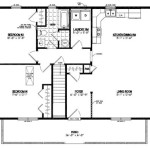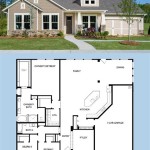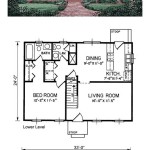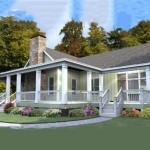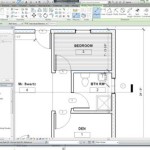Low Country House Plans With Wrap Around Porch Areas
Low Country house plans, characterized by their expansive porches and distinctive architectural details, evoke a sense of Southern charm and relaxation. The inclusion of a wrap-around porch is a defining feature, offering ample outdoor living space and blurring the lines between the interior and exterior environments. These homes are designed to thrive in warmer climates, particularly along the coastal regions of the Southeastern United States, adapting to the environmental conditions and promoting a lifestyle centered around outdoor living and socializing.
The hallmark of Low Country architecture is its emphasis on functionality and comfort. Large windows and doors allow for natural light and ventilation, while elevated foundations and durable building materials mitigate the risk of flooding and insect infestation, common concerns in coastal areas. The wrap-around porch serves as an extension of the living space, providing a shaded retreat from the sun and a breezy spot for entertaining guests or simply enjoying the surrounding landscape. This architectural style represents a thoughtful response to the regional climate and lifestyle, seamlessly blending practicality with aesthetic appeal.
Adaptability to Climate and Location
One of the primary reasons for the enduring popularity of Low Country house plans lies in their inherent adaptability to specific climate and location considerations. Coastal regions are often subject to high humidity, intense sunshine, and the potential for severe weather events. Low Country designs actively address these challenges through several key features. Deep, overhanging eaves and the expansive porch provide shade, minimizing direct sunlight exposure and reducing the need for excessive air conditioning. The elevated foundation, or pier and beam construction, helps to protect the home from flooding, storm surge, and ground moisture. This design approach also allows for air circulation beneath the house, further mitigating humidity and preventing the growth of mold and mildew.
The choice of building materials also reflects the need for durability and resilience. HardiePlank siding, known for its resistance to moisture, insects, and fire, is a common choice. Metal roofing, another popular option, is lightweight, long-lasting, and able to withstand strong winds and heavy rainfall. The use of impact-resistant windows and doors provides added protection against hurricane-force winds and flying debris. By incorporating these features, Low Country house plans are engineered to withstand the rigors of the coastal environment, ensuring the longevity and structural integrity of the home.
Beyond structural considerations, Low Country designs are also adaptable to various site conditions. The elevated foundation allows for construction on uneven or sloping terrain, minimizing the need for extensive site grading. The wrap-around porch can be customized to fit the specific orientation and layout of the property, maximizing views and capturing prevailing breezes. Whether situated on a waterfront lot, nestled among trees, or located in a historic downtown district, Low Country house plans can be tailored to seamlessly integrate with the surrounding landscape and architectural context.
The Significance of the Wrap Around Porch
The wrap-around porch is undoubtedly the most defining feature of a Low Country house plan. More than just an architectural element, it serves as an integral part of the home's living space, fostering a connection with the outdoors and promoting a relaxed, social lifestyle. The porch typically extends around multiple sides of the house, providing panoramic views and creating a seamless transition between the interior and exterior environments. Its generous size offers ample space for seating areas, dining tables, and even outdoor kitchens, making it a versatile space for entertaining guests, relaxing with family, or simply enjoying the tranquility of the surrounding landscape.
Historically, the wrap-around porch served a practical purpose, providing shade and ventilation to help keep the interior of the house cool during hot summer months. In the days before air conditioning, the porch was often the most comfortable place to be, offering a respite from the sun and a breezy spot for socializing. Today, while air conditioning has reduced the need for passive cooling strategies, the porch continues to be a valuable asset, providing a natural extension of the living space and encouraging outdoor living.
The design of the wrap-around porch is often meticulously crafted to enhance its aesthetic appeal and functionality. Columns, railings, and balusters are carefully chosen to complement the overall architectural style of the house. Porch swings, rocking chairs, and comfortable seating arrangements create inviting spaces for relaxation and conversation. Outdoor lighting fixtures provide ambiance and safety, allowing the porch to be enjoyed well into the evening. Landscaping around the porch adds to the sense of privacy and tranquility, creating a secluded oasis where homeowners can escape the stresses of modern life.
The orientation of the porch is a crucial consideration in maximizing its benefits. Ideally, the porch should be positioned to capture prevailing breezes and to provide shade during the hottest parts of the day. The placement of trees and shrubs can further enhance the shading effect and create a more comfortable microclimate. By carefully considering these factors, architects and designers can create a wrap-around porch that is both beautiful and functional, seamlessly integrating with the surrounding environment and enhancing the overall living experience.
Interior Design Considerations
While the exterior features of Low Country house plans are undeniably distinctive, the interior design plays an equally important role in creating a cohesive and comfortable living environment. The interior spaces are often designed to be open and airy, with high ceilings, large windows, and a seamless flow between rooms. This design approach maximizes natural light and ventilation, creating a bright and inviting atmosphere. The connection between the interior and exterior spaces is further emphasized through the use of French doors or sliding glass doors that open onto the wrap-around porch, blurring the lines between indoor and outdoor living.
Traditional Low Country interiors often feature hardwood floors, painted wood paneling, and classic architectural details such as crown molding and wainscoting. These elements add a sense of warmth and character to the space, while also reflecting the historical roots of the architectural style. Fireplaces are often incorporated into the design, providing a focal point for the living room and creating a cozy atmosphere during cooler months. The color palette typically consists of light, neutral tones, such as white, beige, and gray, which help to reflect natural light and create a sense of spaciousness.
Modern Low Country interiors often incorporate contemporary elements while still maintaining the essential characteristics of the style. For example, stainless steel appliances and granite countertops may be used in the kitchen, while clean lines and minimalist furnishings are incorporated into the living spaces. The integration of smart home technology, such as automated lighting and climate control systems, can enhance the comfort and convenience of the home. However, even with these modern updates, the focus remains on creating a comfortable and inviting space that celebrates the connection with the outdoors.
The layout of the interior spaces is also carefully considered to maximize functionality and flow. Open-concept living areas are common, allowing for easy interaction between family members and guests. The kitchen is often designed as the heart of the home, with a large island or peninsula providing ample space for food preparation and socializing. Bedrooms are typically located on the upper floors, providing privacy and separation from the main living areas. Bathrooms are often designed with spa-like features, such as soaking tubs and walk-in showers, creating a relaxing and luxurious retreat.

Plan 46666 Lowcountry With Full Wrap Around Covered Porch And Open Floor

Plan 46666 Lowcountry With Full Wrap Around Covered Porch And Open Floor

House Plans With Wrap Around Porches Southern Living

Low Country House Plans Home For Southern Living Donald A Gardner Interactive Llc

Summertime Lowcountry House Plan Southern Living Plans
Farmhouse Style House Plan 3 Beds 2 5 Baths 1778 Sq Ft 929 77 Floorplans Com

Low Country House Plans Floor Designs Elevated Cottage

Log Home With Wraparound Porch

Country House Plans With Front Porches

Country Style House Plan 4 Beds 5 Baths 4852 Sq Ft 928 1 Dreamhomesource Com
Related Posts


